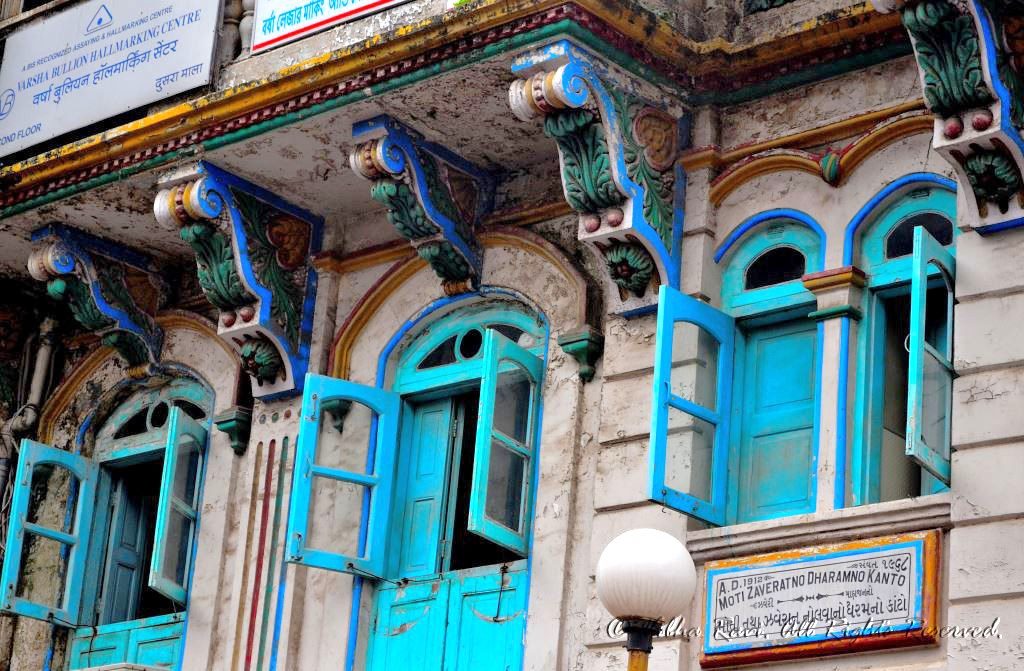It represents all that Mumbai is – Order amid the perceived chaos; Mishmash of the old and new; Meeting ground of the poor and rich; Hub of never-ending activity; Place that all kinds of people call home.
This is Kalbadevi in Mumbai, an area named after a female Hindu deity Kalbadevi.
There are laborers pulling hand carts, hollering to get you out of their way – otherwise they lose momentum and restarting does not involve just turning the ignition key. You hear their sweaty breath, see their tense muscles and wonder whether it would all be worth it at the end of the day.
Then, there are those who leisurely hang around at stalls that sell paan or betel leaf in countless flavours. There are those who barely have enough time to grab a bite at unpretentious roadside eateries, and those whose sole daily entertainment is people watching.
You see holy men inside temples waiting for patrons whose day they can bless while fumes from incense lazily curl up through the air.
Located north of Crawford Market, Kalbadevi is a truly ancient locality of Mumbai city. Crumbling buildings like the historically significant Swadeshi Market, defaced by plants jutting out of crevices and roosting pigeons making gurgling noises remind you of the heritage either we are just not capable of handling or willing to preserve.
Pavements filled with key makers, barbers, cobblers and people eating, walking, haggling, struggling , sleeping and laughing sustain livelihoods of their inhabitants.
Kalbadevi houses Zaveri Bazar that sells diamond and other jewellery, Mangaldas Market, a textiles hub and Chor Bazaar that is famous/infamous for antiques, second hand stuff and counterfeits (called duplicate items in India). As a result, you see all kinds of wares when you walk the lanes – steel boxes piled up as high as gravity will allow, ‘Made in China’ electronics and toys, fresh fruits and veggies, chunky inexpensive but deceptively expensive looking jewellery, beautiful saris, metal utensils etc.
I was visiting the area for lunch at Shree Thakker Bhojanalaya.
The restaurant serves a thali, the food portion of which would leave many less-than-brave hearts clutching their tummies. For the uninitiated, a ‘thali’ comprises a large plate with several katories/vatis (bowls) for savoury items like daal (pulses), vegetable curry, kadhi (tempered curd) and desserts like gulab jamun, kheer, shrikhand etc. Snacks, rice and rotis/chapatis are also served.
The price per thali is fixed (around 300 rupees i.e. less than 5 US dollars during our visit) and you can eat as much or as little as you like. The food is served in a quick succession of courses as waiters float in and out bearing different fare.
(TIP – Don’t fill up on snacks and ghee – wait for the rotis which come later. Ask for the amazing jowari, makka and bajra rotis).
The restaurant – Thakker Bhojanalaya. I love their message – we will pay heed to all your requests, will you accept just one of ours? – Please don’t waste food
As I and my friend took a post-lunch stroll, we chanced upon a hidden gem – a Gujarati temple named ‘Dwarkadheesh temple’ (featured below)
I was not permitted to take pictures inside, but the old worldly ambiance with women putting together garlands for the evening puja, the smell of incense and the calm atmosphere was totally at odds with the world outside.
Having come so far, we decided to visit the Kalbadevi temple. A word of caution here – the temple being tiny is very easy to miss, so keep asking for directions as you go. The good part is there are no vendors to hassle you and it isn’t very crowded. For all its fame it seems more like a routine stop for people living close by rather than a place that religious Hindus from all over flock to.
Having visited one we decided to visit the other one too. Mumba Devi is the patron goddess from whom the city Mumbai derives its name. The atmosphere was not very different from the Siddhi Vinayak temple in Prabhadevi – stalls selling puja offerings, cows chomping on discarded flowers and prasad, people jostling with each other to complete the pradakshina (circling the main sanctorum) , and attendants telling devotees to move along.
After paying obeisance we left with a post card bearing the image of the goddess/Devi (since photography is not permitted at the temple).
Believe it or not, this was my first visit to both the temples in the 15 years that I have spent in Mumbai. I intend visiting again soon. What about you?
How to get there?
You can take a taxi from anywhere in Mumbai city (though the cost could be prohibitive depending on how far you are staying). If you want to take a suburban train, get off at Masjid Bunder station on the Central line or Marine Lines of the Western line and just walk down from there.
There are local BEST buses that will take you to Fort area, Flora Fountain, Victoria Terminus or Churchgate. You could then take a taxi or depending on your energy levels, walk from there.
See more pictures on my Flickrstream
